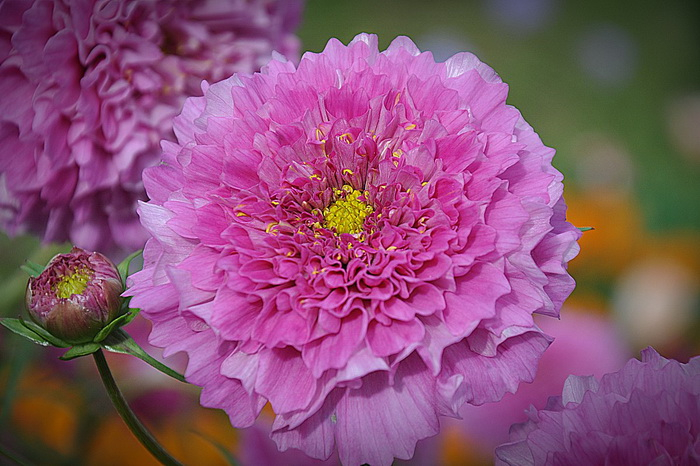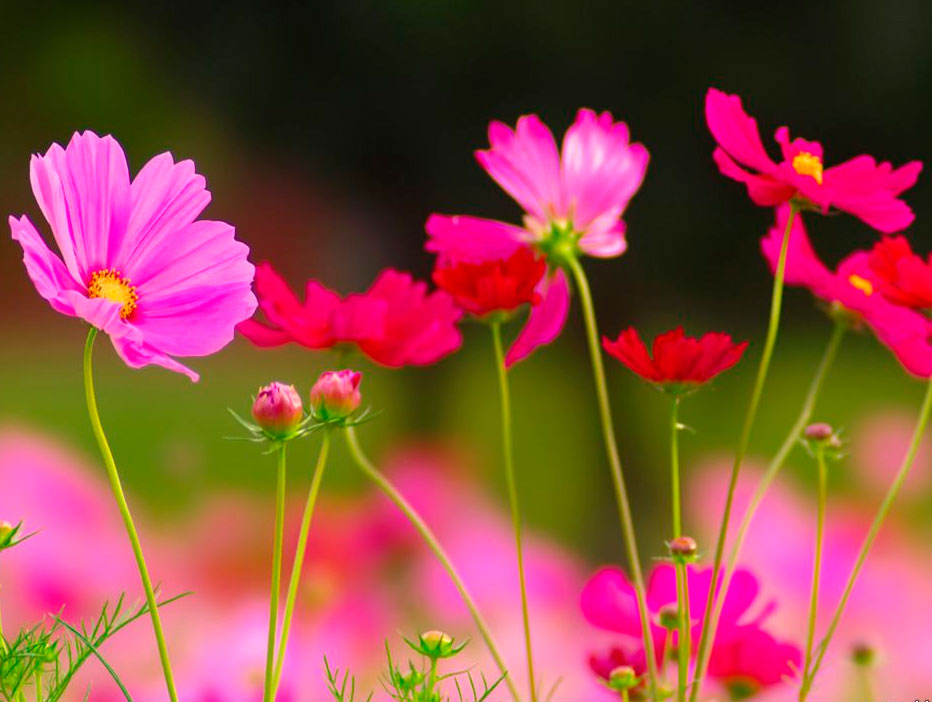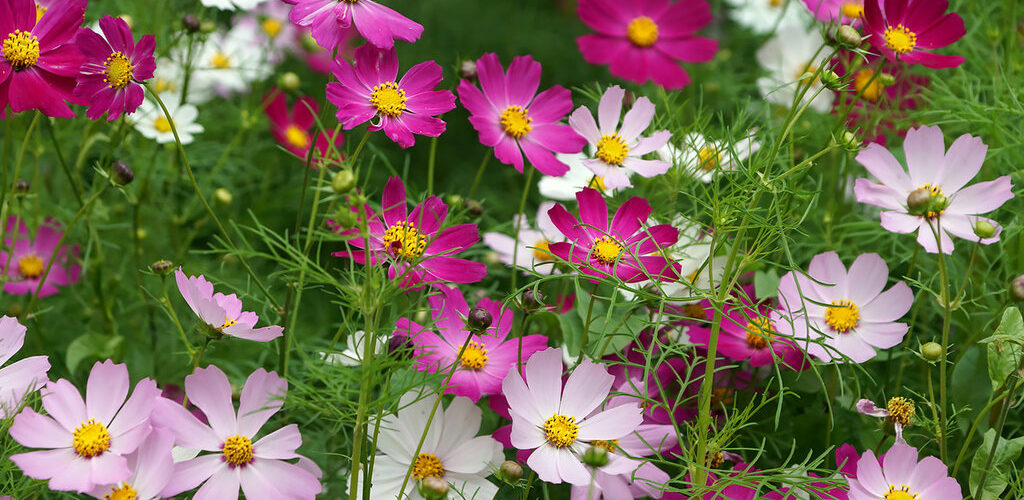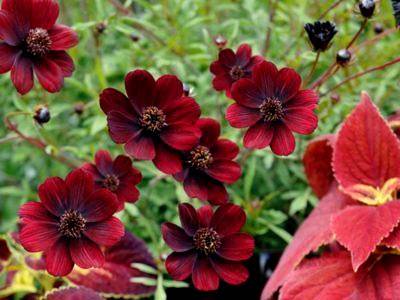Kosmeya landing.
Kosmeya is planted in areas protected from drafts and winds, which are illuminated by the sun's rays all day. The soil for the plant should have a slightly acidic reaction, contain a large amount of drainage and organic fertilizers. Before planting, be sure to dig up the site.
You can plant a plant by seed and seedlings. There is practically no difference, but only shrubs grown from seedlings can bloom a week earlier. Sowing seeds is carried out in early spring, as soon as the snow melts on the site. Seedlings begin to be prepared in April, and are planted in open ground around the end of May, or at the beginning of June. The flowering period is from July to September. After planting, be sure to water the plant abundantly.
Growing and care
Planting and caring for cosme in the open field has its own characteristics. With the seedling method of growing, the planting of young plants begins in the second half of May. They are planted in small holes at a distance of 30 cm from each other. After planting, the plants are watered abundantly.
When the plants reach a height of half a meter, pinch the tops. This technique contributes to better tillering and abundant flowering.
Caring for the cosmos also consists in timely watering, loosening the soil and applying top dressing. Also, do not forget about the timely removal of weeds. Cosmeya should be watered no more than once a week. Its powerful root system perfectly draws moisture even from the deepest soil layers.
To prevent the formation of a soil crust, the soil surface is loosened after each watering. To save time, loosening can be combined with weeding. Timely feeding will significantly improve the appearance of plants and increase the abundance of flowering.
The first time fertilizers are applied two weeks after planting the seedlings. For this, universal mineral complexes are used. The second time is in the budding phase, the third time is during flowering.
With a strong overgrowth of the bushes, you can cut them. It will give the plants a more compact look. Overgrown bushes should be cut off by no more than 30 cm, while already faded inflorescences must get into the pruning zone.
Kosmeya is such a non-demanding and resistant plant that it is almost never damaged by pests and diseases. The main threat to its seedlings is only slugs. It is easy to destroy them, in the aisles you just need to scatter special preparations. With a small number of pests, they can be collected manually.
Planting and caring for cosmos flowers is not difficult at all. This culture reproduces well by self-seeding, having planted it once on your site, you will enjoy its spectacular, abundant and long flowering for many years.
Growing cosmos from seeds

Sowing
For the reproduction of cosme, seeds are used. At the same time, such a culture can be grown through seedlings, or the seeds are sown directly into open soil.
What time is open soil sowing?
Sowing seeds in open soil is done at the beginning of the spring, immediately after all the snow has melted. Seeds should be distributed over the soil surface in nests consisting of 3 or 4 pieces, while the distance between them should be from 0.3 to 0.4 meters. Seeds should be buried shallowly into the soil (no deeper than 10 mm), for this it is enough to lightly slap them with your hand. Flowers grown in this way begin to bloom in July or in the first days of August. Sowing seeds in open soil can be done in late autumn, before winter. Also, this flower culture can reproduce by self-sowing, in the spring. you just need thin out the appeared seedlings.
Seedlings of cosmos

Growing this flowering plant through seedlings is distinguished by its reliability and faster results. Sowing seeds for seedlings is done in March or April. Seeds differing in photosensitivity must be distributed over the surface of the soil mixture, they are not sprinkled on top, but only slightly pressed into the substrate. Then the crops must be moistened, and then the container is covered with a film or glass on top and removed to a well-lit place. The optimum temperature for seed germination is 18 to 20 degrees. If everything is done correctly, then the first seedlings should appear 7-15 days after sowing. If the seedlings grow too densely, then they will need thinning, while the distance between the plants should be from 10 to 15 centimeters. Instead of thinning, the seedlings can be cut down. After the dive, the kosmeya is placed in a cooler place (from 16 to 18 degrees). To avoid picking, sowing seeds can be done in individual cups.
COSMEY GROWING FROM SEEDS... Sowing flowers. ANNUAL FLOWERS
Growing seedlings of chocolate cosmos
Sowing seeds on seedlings in March and early April. Sow in boxes or immediately in separate cups (then you don't have to transplant).
- Fill the containers with light, loose soil, moisten, spread the seeds over the surface, press them a little with your finger.
- Sow 1-2 seeds in cups.
- Cover the crops with foil or glass, germinate in a bright place at a temperature of 18-20 ºC, ventilate the greenhouse, moisten the soil.
- Expect 7-10 days to germinate. Then remove the shelter, reduce the temperature by a couple of degrees.
- Thin seedlings in boxes, leaving a distance of about 10 cm between them.

Cosmeia care
How to grow cosmea
Planting and caring for cosmeas is not burdensome even for beginners in floriculture. Watering the cosmos is carried out once a week, and it should be plentiful - four to five buckets of water should be poured under each bush. After watering, loosen the soil in the area and remove weeds until the kosmeya becomes an adult, strong plant.
Fertilization of cosmos with fertilizers for flowering plants is carried out three times per season: before budding, during it and at the beginning of flowering. For more abundant flowering, you can make foliar dressing - spraying on the leaves with the Bud preparation, but when fertilizing the cosme, remember that moderation is needed in everything. Remove wilting flowers in time.
If the kosmeya in the flowerbed has grown strongly, it can be cut, this will not stop flowering, and the bushes will become compact and more attractive. That, in fact, is all you need to know about growing kosmeya flowers.
Cosmos pests and diseases
Kosmeya is so immune to diseases and pests that it is practically not affected by them. Only slugs and snails pose a threat, and then until the plant comes into force. You will have to deal with mollusks by collecting them by hand. Place bowls with beer on the site and collect gastropods that have crawled to feast on them from time to time.
Kosmeya chocolate in landscape design
Chocolate kosmeya is no longer considered an endangered plant, but even now its seeds are not cheap abroad. We bred it not only with seeds, but also by dividing root crops. Modern varieties are light-loving and cold-resistant, and they also retained their undemandingness to the soil, although, of course, on loose and nutrient-rich soil, the flowers turn out to be much larger and smell like chocolate more intense.

In the garden kosmeya chocolate is always a welcome guest. Low-growing varieties look great in pots and containers, some varieties are grown specifically for cutting. This is truly a versatile plant - with its help you can cover unsightly places on the site or create a romantic mood.
Kosmeya chocolate in landscape design is used to create large arrays along fences and fences.It can be used to create landscape groups, planting in the foreground in front of trees and shrubs during the season. Openwork leaves and light bright flowers will enliven green plantings.
The company of chocolate cosme will be made up of summer varieties of flowers, which are also very common - chamomile, marigolds, echinacea and phlox. Tall varieties are suitable as a hedge to hide unsightly areas on the site. Low-growing varieties can be used to decorate borders in combination with other flowers. Together they will create an enchanting look where the cosmeya will look just beautiful.
Many gardeners believe that this flower is very ancient and beautiful, therefore it is worthy to decorate your flower beds.
Cosmeia care

Even an inexperienced florist can grow a cosmeya in his garden. It is necessary to water this plant regularly, or rather, once every 7 days. At the same time, watering is necessary abundant, so, 4.0 -5.0 liters of water must be poured under each bush. After each watering, it is necessary to loosen the surface of the site, and also weed until the bushes grow and get stronger.
These plants are fed three times a season with fertilizers for flowering plants: before the formation of buds, during the budding period and at the very beginning of flowering. In order for the plant to bloom more magnificently, it can be fed on the foliage with a solution of the Bud preparation. However, it should be borne in mind that this plant must be fertilized in moderation.
Pick off wilted flowers in time. Strongly overgrown bushes, if desired, can be trimmed, which will return them attractiveness and compactness, while flowering will not suffer from this procedure.
Diseases and pests

Kosmeya has a very high resistance to diseases and pests, so they are practically not afraid of them. Until the bushes get stronger, snails and slugs can harm them. If gastropods are found on bushes, then they need to be collected by hand. You can also distribute several beer traps around the site, and you just have to regularly check them and collect pests.
Kosmeya Planting and leaving.
Description of the kosmeya flower
So, kosmeya cultivation, how to grow gorgeous bushes of these bright annual flowers.
Despite the fact that the flowers are annual, they sprout beautifully by self-sowing. Thanks to this, from year to year you will grow beautiful cosme bushes.
The average height of the bushes reaches 1 - 1.2 meters. But today, quite a lot of undersized forms of cosmos with a height of up to 50 cm have been bred. (Sonata, Sonata White, Sonata Carmine ...) and others.
For a long time and stubbornly I did not want to grow cosmos in my area. The problem was not that it was a difficult event.
I considered the cosmos to be some kind of flower from the "century before last", old-fashioned and ugly. Well, where to sculpt them: to my gorgeous rose bushes, or maybe gladioli?
Types and varieties
Several varieties of cosme can be grown in the garden, two of them are annual, and another is perennial (Figure 2).
Since most often kosmeya is grown as an annual crop, consider the popular varieties of this direction:
- Double-feathery differs from other representatives of the species by filamentous leaves, which outwardly resemble dill. Flowers are solitary (in rare cases, they can be collected in small groups), yellow in the middle, and at the edges can be white, pink or purple.
- Sulfur yellow naturally occurs in South America. The plant is quite thermophilic, but with proper care it is also suitable for temperate climates. A distinctive feature is the inflorescences from pale yellow to rich orange.
- Blood red is a perennial cultivar. The flowers have a rich red color, which is more reminiscent of burgundy in shade, and the buds have a pronounced chocolate aroma. It is better to grow this variety in pots, which can be transferred to the house for the winter. If this is not possible, then all the bushes need to be provided with high-quality shelter for the winter.
 Figure 2.Popular varieties of culture: 1 - double-feathery, 2 - sulfur-yellow, 3 - blood-red
Figure 2.Popular varieties of culture: 1 - double-feathery, 2 - sulfur-yellow, 3 - blood-red
Recently, thanks to the efforts of breeders, special double flower hybrids have been bred.
Terry
Among the terry varieties, several unusual species are distinguished at once. For example, Brightness is distinguished by abundant and long flowering, and the buds are painted in bright red.
The terry variety Antiquity also has its own peculiarity: the bush itself is compact, and its buds immediately after opening have a rich red color, which gradually fades and becomes similar to salmon. Also popular is the double click rose bon-bon variety, which is often grown to form bouquets, since flowers can stand for a long time after cutting.
Chocolate
Chocolate cosmeia is also called blood red. Both names have a well-founded origin: in the first case, the plant received such a name due to the characteristic chocolate aroma of the buds, and in the second - due to the rich red hue of the petals.
This variety belongs to perennials, but it is quite capricious in cultivation. Since plants of this type are extremely thermophilic, they are recommended to be planted not in open ground, but in separate pots, so that with the arrival of cold weather the flower can be transferred to the room. If you are unable to do this, the chocolate space will have to provide a reliable shelter for the winter.
Kosmeya dwarf vega
This variety was specially bred by breeders for residents of regions with a harsh climate. The plant is annual, and, unlike its congeners, does not differ in high height. Adult specimens rarely exceed 30 cm in height.
At the same time, the culture is distinguished by its amazing resistance to adverse factors: it tolerates cold and lack of moisture well, and seeds can be sown both in spring and before winter.
Types and varieties
Currently, only three varieties of the plant are grown universally. One of them is perennial, two are perennials. Breeders are constantly crossing different varieties of plants, getting new ones. This is painstaking work, which sometimes gives an amazing and unique result.
Terry kosmeya
Terry kosmeya in another way is called "cosmic beauty". In height, it usually reaches 1.5 m, it is distinguished by openwork-terry petals. Flowers can be of any shade: from white to red. The most popular varieties of the species are:
- Snow click;
- Psyche;
- Pink lollipop;
- Sea shell;
- Cranberry click;
- Orange;
- Iridescent overflows;
- Ladybug.

Terry kosmeya, variety Seashell
Kosmeya chocolate
Another name for chocolate cosme is black or blood red cosme. Its inflorescences are colored maroon. The homeland of this species is Mexico. The flowers exude a chocolate smell. The plant is perennial, it is thermophilic, and therefore, growing it in the garden, you will have to cover it for the winter. The following varieties are considered the most popular:
- Brightness;
- Antiquity;
- Double click rose Bonbon.

What does Brightness look like?
Kosmeya perennial
Perennial kosmeya is the best garden decoration. It propagates by cuttings and blooms before the onset of frost. Withstands not only drought, but also light frosts. Growing in sun-drenched areas, it boasts a large number of inflorescences on the stem, while in shaded areas it stands out thanks to the fluffy stems.
For your information! Despite the fact that the plant is unpretentious, you need to take care of it, feeding it with mineral and organic fertilizers.
Cosmeya double-feathered
Double-feathery cosmea is classified as annuals. Its homeland is the mountainous regions of Mexico. Usually, the height of the bushes varies from 0.8 to 1.5 m. Inexperienced plant breeders may confuse the leaf plates with those of dill. The size of the inflorescences in diameter varies from 7 to 10 cm.
Flowers can be white, purple, red or pink. In the middle of the inflorescence is a small yellow disc.The described species blooms magnificently. They began to breed it back in 1799.The most common varieties of the species today are:
- Dazzler;
- Purity;
- Sonata Pink Blush.
The last variety belongs to undersized plants.

Dazzler variety
Kosmeya sulfur-yellow
Sulfur-yellow cosmea began to be grown in Latin America. This species is thermophilic and belongs to annuals. The height of the bushes usually reaches 1.5 m. Flowers usually have a yellow tint. Common varieties of the species, cultivated since 1799, are:
- Bilbo;
- Crest Lemon;
- Diablo.
Note! The undersized variety is Crest Lemon
Cosmeya sensation
Cosmeya sensation is a tall plant. The bush reaches a height of 0.9-1.2 m, in width it can grow by 30 cm. Inflorescences are usually painted in several shades at the same time, they are quite large, can be 10 cm in diameter. Plant breeders recommend planting this variety along with carnations, chamomiles, marigolds - these are the best neighbors.
Common varieties are:
- Mix of colors;
- white;
- Crimson;
- Candy strike;
- pink.
Important! The presented species grows best in open areas bathed in sunlight. The ideal soil for him is loose and nutritious soil.
Kosmeya yellow
The yellow kosmeya is usually considered one of the varieties of the sulfur-yellow species. Flowers can be bicolor or monochromatic. In the first case, such a result is obtained with artificial breeding. Growing such a cosmos is not difficult, it does not need special care. Like other varieties, yellow reaches 1.5 m in height, boasts large inflorescences, the size of which is 12 cm in diameter.
Growing cosmos from seeds
Mexican aster in nature reproduces independently, scattering seeds around itself. Gardeners prefer to breed cosmea as an annual plant. Therefore, they try to collect achenes in the fall in order to resume the rabatka next year.
Landing features
Growing cosmos is a simple process that even a beginner can easily handle. The seeds of the plant retain good germination for 3 years after being harvested.
If you liked kosmeya growing from seeds when to plant, it is determined in one of the ways:
if a seedling method is planned, then planting is carried out in March-early April in boxes;
they sow in open ground in spring as soon as the snow melts;
some growers practice sowing before winter, taking into account the natural way of propagation of the culture.
Terry Rose Bonbon
Cosmos seeds are cold-resistant, so you don't have to worry about night frosts. But even in a southern climate, when sowing on a flower bed, flowering will not begin until July. For summer residents of the Moscow region and more northern regions, it is recommended to use the seedling method.
How to grow seedlings
To admire the flowers of cosmos in early summer, they take shallow boxes and fill them with a sand-peat mixture. This is followed by the following algorithm:
- each seed is slightly pressed into the ground, without deepening - light should fall on them;
- moisten the earth;
- the box is covered with transparent film and placed on the windowsill.
The room maintains a temperature of + 18-20 ° C until shoots appear. This will happen in a couple of weeks. At this point, the shelter is completely removed and the sprouts are allowed to rise to a height of 10 cm.
Seedlings of garden chamomile
A picking of seedlings is carried out in other containers, maintaining a gap between plants of 10-15 cm. Before transferring to open ground, the cosmea is kept in a room with a temperature of + 16-18 ° C.
To exclude the thinning procedure, initially you can plant 2-3 seeds. in separate cups.
Sitting in the open land
The cold resistance of the plant allows sowing cosmos directly into flower beds. This procedure is carried out in most regions in April. In the southern regions, you can make out rabatki from the end of March.
Any scheme is used: ordinary or square-nested.You need to plant so that there are no more than 6 plants per 1 square meter, otherwise they will interfere with each other. The optimal distance between cosmeas is 0.3-0.5 m.
Important! Too much distance is undesirable, otherwise the bushes will begin to build up green mass to the detriment of flowering. The holes are not made deep - up to 1 cm
Water it carefully so that the seeds do not wash out of the pits. When shoots appear, the plants are looked after as if they were mature bushes. The holes are not made deep - up to 1 cm
Water it carefully so that the seeds do not wash out of the pits. When shoots appear, take care of the plants as if they were mature bushes.
The holes are not made deep - up to 1 cm
Water it carefully so that the seeds do not wash out of the pits. When shoots appear, take care of the plants as if they were mature bushes.
Seed reproduction
How and when to plant cosmeia? Growing from seed is the most suitable way to breed this flower. They can be sown directly into open ground, or they can be planted in containers, and only then the resulting seedlings can be planted on the beds. When is the landing of cosmos in open ground carried out? If you decide to plant seeds directly in open ground, then this procedure is carried out at the very beginning of spring, when there will be no snow at all on the ground. No need to prepare holes or grooves for seeds. They are simply scattered over the surface of the earth in nests - 3-4 grains at a distance of 30-40 centimeters. After that, it is enough just to lightly press them with your palm to the ground so as not to scatter. Remember not to deepen the seeds of this plant more than one centimeter.
The kosmeya will delight with its flowering at the end of July or at the beginning of August, depending on the weather conditions in your region. You can sow Mexican aster before winter. Sowing is carried out somewhere in November, when the air temperature will no longer rise and the seeds will not grow ahead of time.

However, having landed a cosmea on your beds once, you can no longer worry about whether it will rise the next year. Since this flower has no problem with self-seeding. In the spring, it will only be necessary to thin out the beds a little, since the seedlings will be very dense.



















































